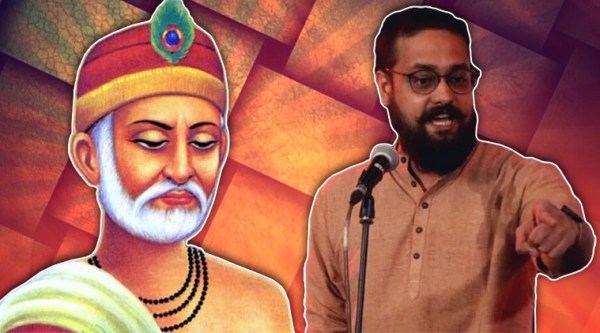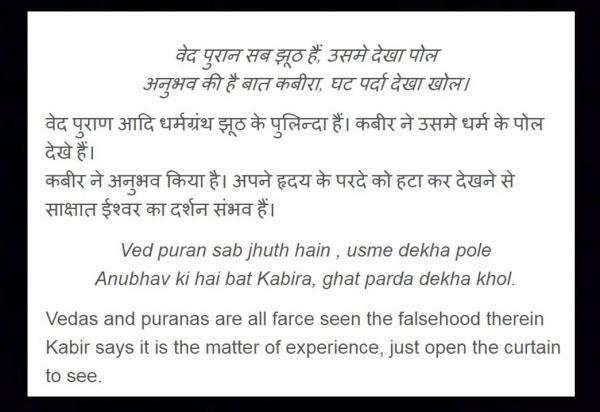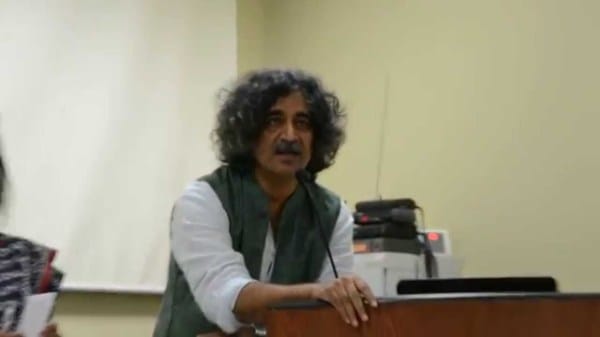As slam poetry finds favour among millennials, someone reminds us of Kabir’s verse
Is slam poetry really a new form of poetry or did it always exist in the form of Kavi Sammelan, Mushaira, and even Kabir's verses in India?

“Kabir was the first slam poet India had.” (Source: Indian Express/ Rajan Sharma)
“People tell me ‘aap kavi hai, celebrity nahi (you are a poet, not a celebrity)’ when I ask for remuneration for my performance,” says Gaurav Tripathi. But Deepak Gupta quotes a different rate for each event he attends: “It depends on the venue, banner, and duration of the program and can be anything in five figures for a corporate event.”
Both perform their poetry on stage, in front of a live audience. While one is famous in the slam poetry circle, the other is known for his hasya kavitaein in the Kavi Sammelan circuit. The two might have their roots (and hearts) in the same place, but the way they are treated is extremely different.
Kavi Sammelan vs Slam Poetry
Slam poetry, that supposedly came to India a few years ago, is the latest trend in the world of poetry. Launched in 2013, Delhi Poetry Slam was the first poetry club of the sort in India. “Poetry slams were prevalent in the west and we wanted to bring it to India as well. We were very nervous when we held the first poetry slam in Delhi, but were soon overwhelmed by the response. More than 400 people came and all the seats were full,” says Saumya Choudhary, founder of Delhi Poetry Slam.
On similarities to Kavi Sammelan, Chaudhary says, “Yes, there has always been a culture of Kavi Sammelan and Mushaira in India, but the thing about spoken word is that it can be combined with other forms of art, including music, theater, dance, storytelling etc. Also, poetry slam is a competition, where people perform spoken word poetry about an issue that is close to them.”
Amandeep Singh, who excels in storytelling via poetry, says “Although spoken word has fewer restrictions, is very difficult to write. It has to be engaging, relatable and cannot have multiple layers and metaphors.”
Poet Deepak Gupta explains how Kavi Sammelan has become like an industry where getting an entry is very difficult. “Kavi Sammelan is a hub of professional poets, but like the entertainment industry, it is very reserved, and this is why so many poetry clubs are coming up for the younger generation.”
Mohammed Sadriwala, who has been performing since 2015, says, “We receive criticism from the senior poets who say that what we do is not poetry. But we do not believe so, poetry is a means of expression and it can be different for everyone.”
Simar Singh, the founder of Unerase Poetry, agrees. “Poetry becomes what you want it to become. It keeps on changing with time and the person, and the only basis of poetry is that it should be relatable and honest.”
“Slam poetry is the hip-hop form of poetry that was born as a form of protest in the US. It speaks to the youth because poets talk about the issues that matter to them,” reasons Ashwani Kumar, senior professor at Tata Institute of Social Sciences and practising poet.
But is slam poetry really a new form of poetry?
While it is correct to say that slam poetry got popular because of the attention it received on social media, it would be wrong to say that it is a new phenomenon. The name ‘slam poetry’ comes from the west, but the concept of spoken word poetry has always been there in India.
“In my opinion,” says Kumar, “Kabir was the finest and the first slam poets India had. He slammed religion, society and used to recite and sing his poems on the streets. Isn’t this what the new-age poets do and call it slam poetry?” But the problem, he says, lies in the fact that religious poets will never be considered as slam poets.
Gaurav Tripathi says the spoken word is the ‘past, present and the future of poetry’. “It has always been there and it is bound to stay, only the medium will change.”
While Kumar feels that the culture of Kavi Sammelan has gone down, Syed Salahuddin won’t agree. He has been organising Kavi Sammelan in Dubai since 2003. “Each year so many people come to attend the Sammelan I hold in Dubai, it shows that Kavi Sammelans and Mushairas are not only prevalent in India but people abroad also enjoy it,” he says.
“Slam Poetry is like a body without organs, and I see young people are getting attracted to slam poetry a lot. Although it does not have the true spirit of a Mushaira, it is good since I feel it can revive the culture of Mushaira and Kavi Sammelan in India,” says Kumar.
When slam poetry came to India from the west, poets in India were primarily performing in the English language, but as it intermingled with the Indian culture, and more vernacular poets were born, it would be correct to say that slam poetry came out to become the new-age Kavi Sammelan for millennials.






















 Kabir’s doha on the vedas and puranas.
Kabir’s doha on the vedas and puranas. Ashwani Kumar, TISS Professor, and practising poet. (Source: YouTube)
Ashwani Kumar, TISS Professor, and practising poet. (Source: YouTube)
No hay comentarios:
Publicar un comentario